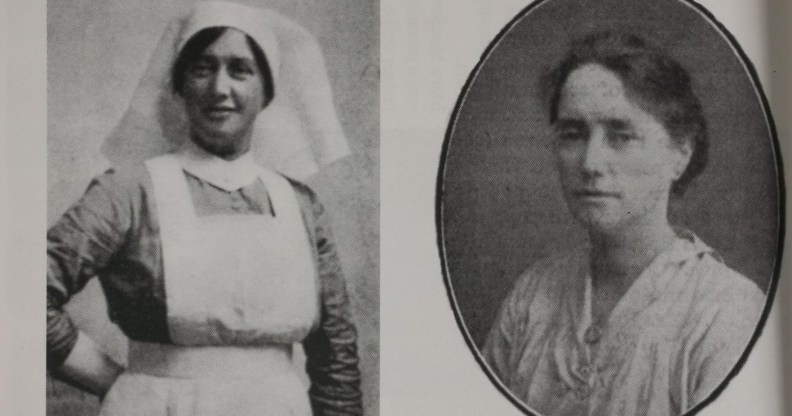New book shines a light on the incredible role queer women played in the Easter Uprising

Elizabeth O’Farrell, a queer woman who played a part in the Easter Rising (Twitter)
Women who lived radical, unflinchingly queer lifestyles played an essential role in Ireland’s Easter Rising of 1916, but most later had their commitment to independence erased. A new book tries to change that.
These women’s identities are explored in a new book by Niall O’Dowd. A New Ireland looks at how Ireland went from being one of the most conservative countries in Europe to one of the most socially liberal, examining social change over the last century and delving into the formative 1916 Rising.
That year, Irish revolutionaries took to the streets of Dublin and seized important buildings in an armed uprising in protest against British rule. Pádraig Pearse, one of the leaders of the Rising, stood on the steps of the General Post Office (GPO) on O’Connell Street and read the Irish proclamation, which declared Ireland to be an independent state.
The Rising was ultimately quelled by British forces and many of its leaders were subsequently executed. Despite this, it was a formative moment that helped set in motion a campaign for freedom that culminated in the formation of the Irish Free State in 1922.
Many of the male revolutionaries who fought for Irish independence are well-remembered, but the role of women was largely forgotten. Among these women were lesbians who lived radical, unflinchingly queer lifestyles, as detailed in O’Dowd’s new book.
A lesbian couple volunteered in the Easter Rising, where they offered care to the wounded.
In an excerpt published by Irish Central, O’Dowd details the lives of the queer women who later had their roles in the Easter Rising all but erased
He quotes historian Mary McAuliffe, who named Elizabeth O’Farrell as one of these revolutionary women in an interview with the Dublin Inquirer. O’Farrell and her partner Julia Grennan were both nurses and they volunteered in the GPO on O’Connell Street in Dublin during the Rising.
“They cared for the wounded, including James Connolly (the founder of the Irish Citizen Army),” McAuliffe said.
O’Farrell was ultimately tasked with carrying the surrender flag when the Irish revolutionaries realised that they were going to be defeated.
Elizabeth O’Farrell was literally erased.
“After days of fighting, the rebels moved to Moore Street, where Pearse decided to surrender,” McAuliffe said.
“When Elizabeth was going to bring out the surrender flag, Julia Grennan talks about the fact that she was terrified and anxious watching her step out onto Moore Street, where there were bullets whizzing around.
O’Farrell survived that moment, but her legacy was subsequently erased. She was famously airbrushed out of a photograph of 1916 commander Pádraig Pearse surrendering to the British Army — but whoever did so didn’t do a great job.
Her boots remained in the photograph, and the incident has become symbolic for the wider erasure of women and queer people from major historic events.
O’Farrell might have been erased from history, but that did not stop her from living a queer lifestyle. After the Rising she spent the rest of her life with Grennan, and when they died they were buried together in Glasnevin Cemetery. Their gravestone reads: “Elizabeth O’Farrell… And her faithful comrade and lifelong friend Sheila [Julia] Grennan.”
O’Garrell and Grennan were not the only queer women to play their part in the Easter Rising. 74 women in total fought for Irish independence in 1916, and there were at least two other queer women among their ranks.
Kathleen Lynn and Madeleine Ffrench-Mullan exchanged love letters following the 1916 Rising.
Dr Kathleen Lynn, a member of the Irish Citizen Army, served as Chief Medical Officer in the GPO and was also a notable suffragette. When she was arrested she described herself as “a Red Cross doctor and a belligerent,” according to O’Dowd.
She was imprisoned in Kilmainham Gaol alongside other women such as Constance Markievicz, the best-known woman of the Rising, and Madeleine Ffrench-Mullan.
McAuliffe said Dr Lynn and Ffrench-Mullan passed love letters to each other, and when they were released from prison they lived together for the rest of their lives.
Ireland was not a welcoming place for women and LGBT+ people both before and after independence, so it is perhaps no surprise that so many had their roles in the fight for independence erased. But without them, Ireland may never have won its freedom.
Five years after the Easter Rising, the Anglo-Irish Treaty was signed giving independence to 26 counties in Ireland. Those counties became known as the Irish Free State, and would later become the Republic of Ireland. The revolutionary period that led to that independence is among the most important in Irish history — but it is only in recent years that the role played by women has been remembered.

